|
AMERICAN
GO E-JOURNAL |
| SHAOYOU OUYANG WINS KGS
TOURNEY TENG & DENG WIN NYC TOURNEY NAIM INTERNET QUALIFIER SET YUNZI STONES NOW LEAD-FREE CONGRESS INCLUDES COMPUTER TOURNEY FUNDS STILL AVAILABLE FOR 3 NAIM QUALIFIER EVENTS GO CALENDAR: Tucson (twice) to Kalamazoo, plus Sacramento & Chicago WOMEN PROS HANG TOUGH IN GG AUCTION CUP KOREA TO FIELD ALL-STAR TEAM AT WMSG UPDATES ON JAPANESE PROFESSIONALS KUIN WINS NL KOREAN AMBASSADORS CUP NL CLUB-TEAM CHAMPS TALKING STONES: A Dispatch From The Front Lines Of Computer Go GO PHOTO: Centennial of Japanese Immigration to Brazil YOUR MOVE: McCallister Remembers Historic NY Go Club; Koester On Placing Stones THE TRAVELING BOARD: Ancient Go in Shaanxi GO CLASSIFIED MEMBER'S
EDITION BONUS CONTENT: |
June 23, 2008; Volume 9, #31
SHAOYOU OUYANG WINS KGS TOURNEY: Shaoyou Ouyang (l) won the KGS
Suk Choi Amateur Invitational on Sunday afternoon, besting Andy Liu in
the third and final round for a 2-1 score. Fernando Aguilar was awarded
the Fighting Spirit prize. Round 2 on Saturday featured an exciting ko
and Liu’s win on time made the score 1-1 and forced the
decisive final round on Sunday. Though
KGS
Suk Choi Amateur Invitational on Sunday afternoon, besting Andy Liu in
the third and final round for a 2-1 score. Fernando Aguilar was awarded
the Fighting Spirit prize. Round 2 on Saturday featured an exciting ko
and Liu’s win on time made the score 1-1 and forced the
decisive final round on Sunday. Though Ouyang
was slightly ahead in the final round, “Andy played a
wonderful yose and got the game very close,” reports Akane
Negishi of KGS, who was the
Tournament Director. “Many thanks to the sponsor, Mr. Suk B.
Choi,” (r) Negishi says, “thanks to all the
participants for the exciting games, and to the all KGS users for
watching!” The final two games over the weekend each drew
more than 850 observers. Both game records – with special
commentary for the E-Journal by Jie Li 9d -- are attached. Click
here for full results and game records.
Ouyang
was slightly ahead in the final round, “Andy played a
wonderful yose and got the game very close,” reports Akane
Negishi of KGS, who was the
Tournament Director. “Many thanks to the sponsor, Mr. Suk B.
Choi,” (r) Negishi says, “thanks to all the
participants for the exciting games, and to the all KGS users for
watching!” The final two games over the weekend each drew
more than 850 observers. Both game records – with special
commentary for the E-Journal by Jie Li 9d -- are attached. Click
here for full results and game records. 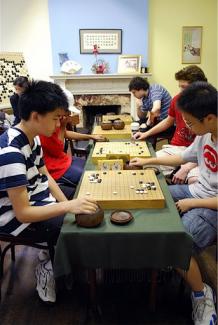 divisions in the June 15th New York Go Center tournament. Eighteen
players turned out for the third in the Center’s 7-part
tournament. “I was very happy to see Carrie and Saul Lapidus,
two New York Go Center veterans, come to play,” reports
organizer Boris Bernadsky. “They had not been making it to
the recent tournaments, and seeing them again was nice.”
Alfred Teng 2d took first place in the Dan Division and Greg Deng 8k
took first place for the Kyu division. The Center’s next
tournament -- a special 8-round Blitz Tournament -- will be held July
12th. Photo by Carrie Lapidus; click
here for more photos
divisions in the June 15th New York Go Center tournament. Eighteen
players turned out for the third in the Center’s 7-part
tournament. “I was very happy to see Carrie and Saul Lapidus,
two New York Go Center veterans, come to play,” reports
organizer Boris Bernadsky. “They had not been making it to
the recent tournaments, and seeing them again was nice.”
Alfred Teng 2d took first place in the Dan Division and Greg Deng 8k
took first place for the Kyu division. The Center’s next
tournament -- a special 8-round Blitz Tournament -- will be held July
12th. Photo by Carrie Lapidus; click
here for more photos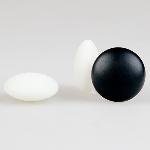

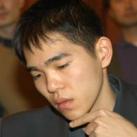 Japan’s
Nihon Ki-in and the China Qiyuan – who are both fielding
strong teams -- the Hankuk Kiwon in Korea has announced an all-star
team for the 2008 World Mind Sports Games (WMSG), reports Thomas
Hsiang. “A dozen male pros, nine female pros and three
amateurs will make up the team to be led by Lee Sedol (l) and Park
Younghoon,” Hsiang tells the EJ. The pros include all of the
top 14 players currently ranked, except Lee Changho and Cho Hoonhyun.
The amateurs will be chosen by a tournament currently under way.
“Other players notably absent are the two Nihon Kiin Korean
residents, Cho Chikun and Ryu Shikun who, by WMSG rules, cannot play
for Japan either,” notes Hsiang. The KBA has promised a bonus
of 5 million Won, or about $5,500 US, to any of their players who wins
a gold medal. In other WMSG news, eight posters featuring the games of
the competition are now available online
and are in both English and Chinese.
Japan’s
Nihon Ki-in and the China Qiyuan – who are both fielding
strong teams -- the Hankuk Kiwon in Korea has announced an all-star
team for the 2008 World Mind Sports Games (WMSG), reports Thomas
Hsiang. “A dozen male pros, nine female pros and three
amateurs will make up the team to be led by Lee Sedol (l) and Park
Younghoon,” Hsiang tells the EJ. The pros include all of the
top 14 players currently ranked, except Lee Changho and Cho Hoonhyun.
The amateurs will be chosen by a tournament currently under way.
“Other players notably absent are the two Nihon Kiin Korean
residents, Cho Chikun and Ryu Shikun who, by WMSG rules, cannot play
for Japan either,” notes Hsiang. The KBA has promised a bonus
of 5 million Won, or about $5,500 US, to any of their players who wins
a gold medal. In other WMSG news, eight posters featuring the games of
the competition are now available online
and are in both English and Chinese. Japanese
pros have made it to the semifinals in the Fujitsu Cup, two are still
in the running in the third round of the LG Cup, namely, Kono Rin 9P
(r) and Yamashita Keigo 9P. None of the international titles is
currently held by a Japanese player. On the national scene, Cho U 9P
holds five current titles: Meijin, Gosei, Agon Cup, Ryusei, and NHK
Cup, and is at the top of the list in this regard. Two players hold two
each of the top seven titles: Yamashita Keigo 9P has the Kisei and Oza,
and Takao Shinji 9P has the Honinbo and Judan as well as the fast play
Internet Daiwa Cup. The other top title, the Tengen, is held by Kono
Rin 8P, who also holds the NEC Cup title. Iyama Yuta 7P holds the
Shinjin O title and continues to look like the brightest star among the
younger generation. He has a very good chance of being the next
challenger for the Meijin, has made it to the second round of the
Judan, and is in the semifinals of the Oza. Iyama also continues to top
the list of Japanese pros with the most wins in 2008, having a 28 and 7
record for an amazing 80% winning rate. Among the women, teen Xie Yimin
3P holds both the Women's Honinbo and the Women's Meijin. Umezawa
Yukari 5P has the Kisei, which she successfully defended early this
year. Suzuki Ayumi 4P is again the Strongest Woman. Readers will recall
that she held that title when Jie
Li 9d defeated her in 2004 in the Seimitsu Cup.
Japanese
pros have made it to the semifinals in the Fujitsu Cup, two are still
in the running in the third round of the LG Cup, namely, Kono Rin 9P
(r) and Yamashita Keigo 9P. None of the international titles is
currently held by a Japanese player. On the national scene, Cho U 9P
holds five current titles: Meijin, Gosei, Agon Cup, Ryusei, and NHK
Cup, and is at the top of the list in this regard. Two players hold two
each of the top seven titles: Yamashita Keigo 9P has the Kisei and Oza,
and Takao Shinji 9P has the Honinbo and Judan as well as the fast play
Internet Daiwa Cup. The other top title, the Tengen, is held by Kono
Rin 8P, who also holds the NEC Cup title. Iyama Yuta 7P holds the
Shinjin O title and continues to look like the brightest star among the
younger generation. He has a very good chance of being the next
challenger for the Meijin, has made it to the second round of the
Judan, and is in the semifinals of the Oza. Iyama also continues to top
the list of Japanese pros with the most wins in 2008, having a 28 and 7
record for an amazing 80% winning rate. Among the women, teen Xie Yimin
3P holds both the Women's Honinbo and the Women's Meijin. Umezawa
Yukari 5P has the Kisei, which she successfully defended early this
year. Suzuki Ayumi 4P is again the Strongest Woman. Readers will recall
that she held that title when Jie
Li 9d defeated her in 2004 in the Seimitsu Cup. Ambassadors
Cup (KAC) in the Netherlands, a four round knock-out held June 21-22 to
decide participation in the PM Cup later this year in Korea. Runner-up
was Robert Rehm 5d. Kuin had been runner-up last year, has won the last
two Dutch national titles, once won 7th place at the World Amateur Go
Championships, and will play for The Netherlands in the upcoming World
Mind Sports Games in Beijing. In between China and Korea he hopes to
study in Japan. This year the KAC was part of the Utrecht tournament,
in which fifty more players took part. Michiel Eijkhout 6d won the
Utrecht Cup. Yoon Young-sun 5P was present all weekend for game
commentary.
Ambassadors
Cup (KAC) in the Netherlands, a four round knock-out held June 21-22 to
decide participation in the PM Cup later this year in Korea. Runner-up
was Robert Rehm 5d. Kuin had been runner-up last year, has won the last
two Dutch national titles, once won 7th place at the World Amateur Go
Championships, and will play for The Netherlands in the upcoming World
Mind Sports Games in Beijing. In between China and Korea he hopes to
study in Japan. This year the KAC was part of the Utrecht tournament,
in which fifty more players took part. Michiel Eijkhout 6d won the
Utrecht Cup. Yoon Young-sun 5P was present all weekend for game
commentary. GO
PHOTO: Centennial of Japanese Immigration to Brazil
GO
PHOTO: Centennial of Japanese Immigration to Brazil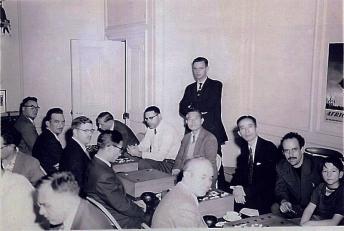 opponent is Bob Gillooly who was the first New York player to go to
Japan to study the game. He returned a shodan. The player to Lasker's
left (right in the photograph) is Eddie Andrelos one of the strongest
NY players at the time. The man standing behind Andrelos is John
Goodell who produced and marketed an inexpensive go set at the time
selling some 5,000, as I remember. The player seated in front of
Goodell is John Matsumoto a fine gentleman and who was one of the most
helpful of the experienced players in helping us to learn the game.
Next to John is, as you have identified is Mitsuo Horiguchi who made it
possible for the New York Go club to have a playing site at the time.
The old Nippon Club had disappeared during World War II and he was
selected to re-establish the club, which he did on East 96th Street in
New York. He was a great friend of American Go and a good personal
friend. Next to Horiguchi San is Dolf Rossof who was very active in the
New York Go world at the time. Next to Dolf is Micah Feldman who was
learning the game and who I believe is still active in Massachusetts.
Micah is playing with Koshi Takashima who was a sort of Go Saint to the
American players of the time. He goes back to time of Go at Lee
Chumleys and I believe was in a photograph that appeared in Life
Magazing in February 1942. Takashima-san provided many of the
translations which appeared in the early editions of The American Go
Journal and served as a Technical Advisor in the production of AGA
Journal at that time. Norbert Jay, a very active NY player at the time
is playing the game with Horiguchi-san. And finally in the lower left I
am shown playing a game with someone, don't remember who. I was
secretary of the American Go Association at the time and one of the
editors of The American Go Journal at the time. The two people sitting
across from Andrelos are familiar, but I don't recall the names at this
time.” McCallister, 86, now lives in Winchester,
VA, and still plays go, "on the internet these days," where he can play
with old friends around the world, he tells the EJ
opponent is Bob Gillooly who was the first New York player to go to
Japan to study the game. He returned a shodan. The player to Lasker's
left (right in the photograph) is Eddie Andrelos one of the strongest
NY players at the time. The man standing behind Andrelos is John
Goodell who produced and marketed an inexpensive go set at the time
selling some 5,000, as I remember. The player seated in front of
Goodell is John Matsumoto a fine gentleman and who was one of the most
helpful of the experienced players in helping us to learn the game.
Next to John is, as you have identified is Mitsuo Horiguchi who made it
possible for the New York Go club to have a playing site at the time.
The old Nippon Club had disappeared during World War II and he was
selected to re-establish the club, which he did on East 96th Street in
New York. He was a great friend of American Go and a good personal
friend. Next to Horiguchi San is Dolf Rossof who was very active in the
New York Go world at the time. Next to Dolf is Micah Feldman who was
learning the game and who I believe is still active in Massachusetts.
Micah is playing with Koshi Takashima who was a sort of Go Saint to the
American players of the time. He goes back to time of Go at Lee
Chumleys and I believe was in a photograph that appeared in Life
Magazing in February 1942. Takashima-san provided many of the
translations which appeared in the early editions of The American Go
Journal and served as a Technical Advisor in the production of AGA
Journal at that time. Norbert Jay, a very active NY player at the time
is playing the game with Horiguchi-san. And finally in the lower left I
am shown playing a game with someone, don't remember who. I was
secretary of the American Go Association at the time and one of the
editors of The American Go Journal at the time. The two people sitting
across from Andrelos are familiar, but I don't recall the names at this
time.” McCallister, 86, now lives in Winchester,
VA, and still plays go, "on the internet these days," where he can play
with old friends around the world, he tells the EJ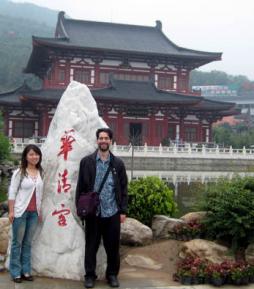 to
study go seems incomprehensible to colleagues and friends back home as
well as people here in China, where the game originated. People from
both cultures think I must really be obsessed, but I am not alone: over
20 people from 13 different countries are enrolled in the Experience Go
in China program I’m attending for the next (period of time).
We speak seven different languages, range in age from 18 to 42
(I’m the oldest) and while most of us are men, there are also
two women attending. Our greenest player is a 10 kyu from Cork,
Ireland, our strongest a 5 dan from Germany, with the great bulk of us
between 2 and 4 kyu. In addition to sharing a love of go, we all speak
English, which is the language in which all classes will be taught. The
program officially begins this week, but I arrived a week early for
sightseeing. I will be posting regularly on the Tigersmouth website,
where interested readers can see photos and get updates on my
activities; look for threads named “Paul’s
China Trip”
to
study go seems incomprehensible to colleagues and friends back home as
well as people here in China, where the game originated. People from
both cultures think I must really be obsessed, but I am not alone: over
20 people from 13 different countries are enrolled in the Experience Go
in China program I’m attending for the next (period of time).
We speak seven different languages, range in age from 18 to 42
(I’m the oldest) and while most of us are men, there are also
two women attending. Our greenest player is a 10 kyu from Cork,
Ireland, our strongest a 5 dan from Germany, with the great bulk of us
between 2 and 4 kyu. In addition to sharing a love of go, we all speak
English, which is the language in which all classes will be taught. The
program officially begins this week, but I arrived a week early for
sightseeing. I will be posting regularly on the Tigersmouth website,
where interested readers can see photos and get updates on my
activities; look for threads named “Paul’s
China Trip” ught me to
Xi'An, but everywhere I turn I see other amazing things as well. Our
guide informed me that we had taken in ten major sights in four days,
no wonder I was completely exhausted and my feet were aching. I had a
pleasant and unexpected go related surprise at the Shaanxi history
museum. In preparation for the Olympics they had an exhibit of games
and sports, and our favorite, Wei Qi (as go is known in China) was
prominently featured. In fact, they had on display the earliest known
go board (r) in history, which was carved on stone and found at the
guardhouse for the tomb of emperor Han Yang around 148 B.C.E. I had
visited that site the day before, and my guide told me that the oldest
go board had been found there. She knew I was into go and did a little
research for our trip. She didn't know the board was actually on
display at the Shaanxi museum though, so we were both surprised. They
had stones too, from a different set around the same time. They were
like pebbles actually, but sorted into black and white. There were also
stones from the Song dynasty, over 1,000 years later, which had celadon
bowls that were very lovely. Though I have heard that Chinese go stones
are traditionally flat on one side, I found numerous stones on display
from the Tang and Sung Dynasties, most of which were double convex. I
found more go-related items in my visit to Ping Yao, which
I’ll report on in next week’s EJ.
ught me to
Xi'An, but everywhere I turn I see other amazing things as well. Our
guide informed me that we had taken in ten major sights in four days,
no wonder I was completely exhausted and my feet were aching. I had a
pleasant and unexpected go related surprise at the Shaanxi history
museum. In preparation for the Olympics they had an exhibit of games
and sports, and our favorite, Wei Qi (as go is known in China) was
prominently featured. In fact, they had on display the earliest known
go board (r) in history, which was carved on stone and found at the
guardhouse for the tomb of emperor Han Yang around 148 B.C.E. I had
visited that site the day before, and my guide told me that the oldest
go board had been found there. She knew I was into go and did a little
research for our trip. She didn't know the board was actually on
display at the Shaanxi museum though, so we were both surprised. They
had stones too, from a different set around the same time. They were
like pebbles actually, but sorted into black and white. There were also
stones from the Song dynasty, over 1,000 years later, which had celadon
bowls that were very lovely. Though I have heard that Chinese go stones
are traditionally flat on one side, I found numerous stones on display
from the Tang and Sung Dynasties, most of which were double convex. I
found more go-related items in my visit to Ping Yao, which
I’ll report on in next week’s EJ.